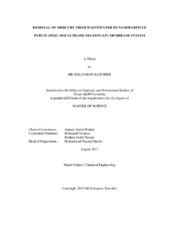| dc.description.abstract | This research investigated the removal of mercury by Reactive Adsorbent Membrane (RAM) hybrid filtration process to attain high quality water from wastewater or water resources contaminated with Hg(II), while producing stable final residuals. Pyrite (FeS2) nanoparticles were employed as the reactive adsorbent and the FeS2-contacted mercury residuals were separated by either Dead End Ultrafiltration (DE-UF) or Cross Flow Ultrafiltration (CF-UF) system.
The first task of this research was to synthesize pyrite nanoparticles with high purity in short reaction time. Microwave irradiation process was used to synthesize pyrite as microwave digestion method has the advantage of producing fine particles of highly pure pyrite with minimal reaction time. Scanning electron microscopy (SEM) and Energy dispersive X-ray spectroscopy (EDS/EDX) were used to characterize pyrite. Synthesized pyrite were used in all experiments. Reaction mechanism for Hg(II) removal by pyrite and behavior of the treatment system were characterized by observing flux decline, pH change, and Hg and Fe concentration in permeate water with time. Effects of the presence of anions (Cl-, SO42-, NO3-) and natural organic matter (HA) on Hg(II) removal were investigated. Also, stability of final residuals was evaluated by using thiosulfate solution (Na2S2O3) as desorbing reagent. This study also examined the possibility of continuous removal of mercury by reusing Hg/pyrite laden membrane to remove additional Hg(II) contaminated water.
Analytical techniques used in this study included cold vapor atomic absorption spectrometry (CV-AAS) for mercury measurement, inductively coupled plasma optical emission spectrometry (ICP-OES) for Fe measurement and thermo triode pH meter calibrated with 4, 7 and 10 pH buffers for pH measurement. The surface of Hg/pyrite-deposited membranes were characterized using surface analysis techniques, including scanning electron microscopy (SEM) for sample's surface topography and X-ray photoelectron spectroscopy (XPS) to analyze the surface chemistry (oxidation state) of solids.
Results of this research indicated that the Hg(II)-contacted FeS2 was completely rejected by both dead-end and cross-flow ultrafiltration membrane system regardless of the presence of anions and humic acid. However, Hg(II) removal was accompanied by considerable flux decline and pH change. Desorption tests were conducted using thiosulfate and almost no release of Hg(II) or iron was observed in permeate water indicating that the formed residuals are very stable. Recycle test showed that this system successfully achieved the goal of continuous and complete removal of mercury from water. | en |


